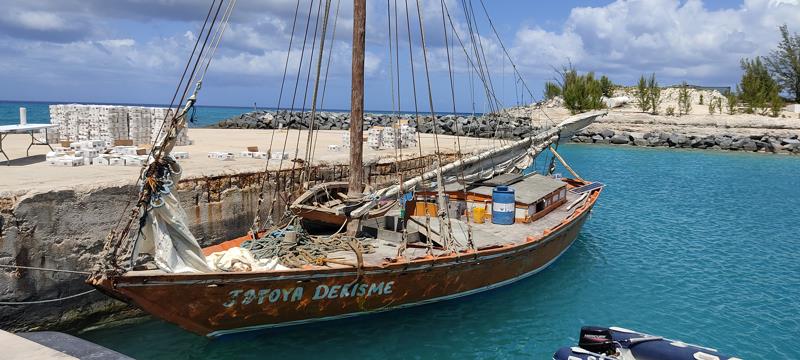
RoRC report from the Bahamas
by Sue and Andy Warman 6 Jun 2022 19:20 UTC

The Rum Boat from Haiti © Sue and Andy Warman
Our leisurely month in Cartegena concluded with an inland road trip with OCC members Brett & Mandy (s/y Leventeia) to Monpox.
The once important colonial river trading town is now a UNESCO site and normally a hive of tourist activity. Post the Covid era it was quiet with few visitors present.
Back to Spruce and we set off towards Cuba two days later. Notable features of Cartagena in Colombia are rampant barnacle growth and strong NE winds offshore, accelerated by the mountainous Sierra Nevada. Gale force is frequent during the trade wind season with steep, short seas generated. When the winds abate for a day or two they typically back to a more northerly direction, however, a strong west going current remains. The plan was to get 100 miles away from the coast before the next cycle of windier weather, the course that can be laid is only west of north, the current pushes one even farther west. Fanciful ideas to pass east of Jamaica were abandoned: beating and a two-knot foul current made progress in that direction painfully slow. Arrival on the west side timed badly with increasing winds in the passage between Cuba & Jamaica: faced with beating into winds up to 30-knots and a ubiquitous strong foul current, we gave up on Santiago and laid a course past the Cayman Islands to Cayo Largo, much farther west. A moonless night-time encounter at sea: a flashing torch and sudden shouting male voices close by. Pirates? Refugees from Haiti? Escapees? Distressed Mariners? How many people? Two of us aboard and potentially vulnerable to an unquantifiable risk, particularly in these waters. We quickly decided to sail on, but passed relevant information to a US-MRCC for appropriate action.
On reflection, going the "wrong way" in the Caribbean, fighting her short steep seas, contrary currents and winds is wretched. Perhaps we should have ignored insurance caveats and departed Panama before the end of the hurricane season and motored our way east to the ABC Islands: but Covid restrictions add another veneer of difficulty to moving anywhere, particularly when going "uphill" with short weather windows.
Santiago and the Windward Passage now lay 500 miles eastwards, upwind and into the current: our route to the Southern Bahamas. Rumour strongly suggested the South Coast of Cuba was a place not to be missed. Our experience did not concord. Possibly exacerbated by economic sanctions and the pandemic; the overarching bureaucracy, prohibition to land in any place other than an official marina, leads us to believe Cuba is not a cruising destination. Perhaps the north coast is different.
There was indeed interesting colonial period architecture in Cienfuegos and Santiago. Old American cars abound, some lovingly restored others battered and rusty but still viable; former Soviet block vehicles are also plentiful: Ladas, Trabants. Emissions standards are clearly less rigorous than in Europe. Intentions to rent a vehicle and tour inland were dashed due to a month wait for availability. Friendly locals are clearly having a hard time. Shortages of food and imported items evident, snaking queues outside shops with new deliveries patiently waited. Tourist restaurants in the old centres appear to be supplied adequately. On the fringes (we like to sample local culture) cafes had little food and even coffee was often not in stock. It felt awkward as a "tourist" to be offered access to items unavailable to locals. We were glad to have arrived with a well-provisioned store on board. However, attempts to take "gifts" for locals were complicated by airport-style security when going ashore.
Now we are in the Bahamas. Great Inagua was our first stop. What a change. Clear waters, vivid colours, accommodating officials. A chilled island atmosphere enveloped us. Thankfully, we felt able to relax. It surprised us how much easier things have suddenly become with English an official language. The past thirty months have been spent in French and Spanish cultures. The Bahamas are easy on the eye. Beautiful turquoise hues brightly glow with a frame of coral and limestone sand beaches. Our draft at 2.1 metres does call for care and some limitations where one can venture, but we are thoroughly enjoying the last couple weeks here before we sail for the Azores; back on a more traditional route we can hopefully make our way eastwards towards Europe without battling the elements quite as much.
Quick Links:
This article has been provided by the courtesy of Ocean Cruising Club.